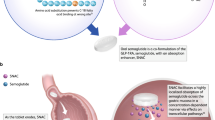Summary.
In two 4-week polysomnography pilot studies with 10 patients each, we investigated the efficacy of oral lisuride as monotherapy in de novo RLS patients as well as in combination with levodopa in advanced RLS. Daily doses at study end were 0.3 mg lisuride, plus 150 mg levodopa in the combination study. Marked improvements occurred in both studies in different PLM indexes and in the CGI. Levodopa dose could be decreased by 27%. Lisuride might be an efficacious treatment for RLS in general, and in combination with levodopa in advanced stage.
Similar content being viewed by others
References
R Allen D Picchietti W Hening C Trenkwalder AS Walters J Montplaisir (2003) ArticleTitleRestless legs syndrome: diagnostic criteria, special considerations, and epidemiology. A report from the Restless Legs Syndrome Diagnosis and Epidemiology Workshop at the National Institute of Health. Sleep Med 4 101–119 Occurrence Handle14592341
R Allen PM Becker R Bogan M Schmidt CA Kushida JM Fry JS Poceta D Winslow (2004) ArticleTitleRopinirole decreases periodic leg movements and improves sleep parameters in patients with restless legs syndrome. Sleep 27 907–914 Occurrence Handle15453549
H Beneš B Kurella J Kummer J Kazenwadel R Selzer R Kohnen (1999) ArticleTitleRapid onset of action of levodopa in restless legs syndrome: a double-blind, randomised, multi-center, crossover trial. Sleep 22 1073–1081 Occurrence Handle10617168
H Beneš CR Heinrich MA Ueberall R Kohnen (2004) ArticleTitleLong-term safety and efficacy of cabergoline for the treatment of idiopathic restless legs syndrome: results from an open-label 6-month clinical trial. Sleep 27 674–682 Occurrence Handle15283002
Beneš H (2005) Transdermal lisuride: first efficacy and tolerability study in patients with severe Restless Legs Syndrome. Sleep Med (E-pub ahead of print)
Diagnostic Classification Steering Committee, Thorpy MJ, Chairman (1990) ICSD – International Classification of Sleep Disorders: diagnostic and coding manual. American Sleep Disorders Association, Rochester, Minnesota
WA Hening RP Allen CJ Earley DL Picchietti MH Silber InstitutionalAuthorNameRestless Legs Syndrome Task Force of the Standards of Practice Committee of the American Academy of Sleep Medicine (2004) ArticleTitleAn update on the dopaminergic treatment of restless legs syndrome and periodic limb movement disorder. Sleep 27 560–583 Occurrence Handle15164915
Horowski R, Obeso JA (1995) Lisuride – a direct dopamine agonist in the treatment of Parkinson’s disease. In: Koller WC, Paulson G (eds) Therapy of Parkinson’s disease. Marcel Dekker, New York, pp 219–248
National Institute of Mental Health (1976) 028 CGI. Clinical Global Impressions. In: Guy W (ed) ECDEU assessment manual for psychopharmacology. National Institute for Mental Health, Rockville, MD, pp 218–222
WH Oertel H Beneš S Happe R Kohnen M Leroux K Stiasny-Kolster (2004) ArticleTitleEfficacy of cabergoline for the treatment of sensori-motor symptoms and sleep disturbances in restless legs syndrome: a placebo-controlled, 5-week, double-blind, randomized, multicenter, polysomnographic study. Mov Disord 19 IssueIDSuppl 9 S425
CW Olanow Y Agid Y Mizuno A Albanese U Bonucelli P Damier J De Yebenes O Gershanik M Guttman F Grandas M Hallett O Hornykiewicz P Jenner R Katzenschlager WJ Langston P LeWitt E Melamed MA Mena PP Michel C Mytilineou JA Obeso W Poewe N Quinn R Raisman-Vozari AH Rajput O Rascol C Sampaio F Stocchi (2004) ArticleTitleLevodopa in the treatment of Parkinson’s disease: current controversies. Mov Disord 19 997–1005 Occurrence Handle15372588 Occurrence Handle10.1002/mds.20243
K Stiasny-Kolster H Beneš I Peglau M Hornyak B Holinka K Wessel W Emser M Leroux R Kohnen WH Oertel (2004) ArticleTitleEffective cabergoline treatment in idiopathic restless legs syndrome. Neurology 63 2272–2279 Occurrence Handle15623686 Occurrence Handle1:STN:280:DC%2BD2cnkslWjtQ%3D%3D
K Stiasny-Kolster R Kohnen E Schollmayer JC Moller WH Oertel (2004) ArticleTitlePatch application of the dopamine agonist rotigotine to patients with moderate to advanced stages of restless legs syndrome: a double-blind, placebo-controlled pilot study. Mov Disord 19 1432–1438 Occurrence Handle15390055
C Trenkwalder D Garcia-Borreguero P Montagna E Lainey AW de Weerd P Tidswell G Saletu-Zyhlarz W Telstad L Ferini-Strambi InstitutionalAuthorNameTherapy with Ropinirole; Efficacy and Tolerability in RLS 1 Study Group (2004) ArticleTitleRopinirole in the treatment of restless legs syndrome: results from the TREAT RLS 1 study, a 12 week, randomised, placebo controlled study in 10 European countries. J Neurol Neurosurg Psychiatry 75 92–97 Occurrence Handle14707315 Occurrence Handle1:STN:280:DC%2BD2c%2FjvVSguw%3D%3D
Walters AS, Ondo WG, Dreykluft T, Grunstein R, Lee D, Sethi K (2004) Ropinirole is effective in the treatment of restless legs syndrome. TREAT RLS 2: a 12-week, double-blind, randomized, parallel-group, placebo-controlled study. Mov Disord: 1414–1423
Author information
Authors and Affiliations
Rights and permissions
About this article
Cite this article
Beneš, H., Deissler, A., Rodenbeck, A. et al. Lisuride treatment of Restless Legs Syndrome: first studies with monotherapy in de novo patients and in combination with levodopa in advanced disease. J Neural Transm 113, 87–92 (2006). https://doi.org/10.1007/s00702-005-0386-1
Received:
Accepted:
Issue Date:
DOI: https://doi.org/10.1007/s00702-005-0386-1




